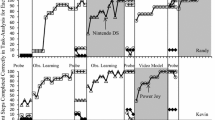Abstract
Children with an autism spectrum disorder (ASD) often have reduced play skills, interfering with their ability to interact with same-age peers. One way that children interact is to play structured games; thus, teaching children with ASD to play structured games may give them additional opportunities to interact with peers. The purpose of this study was to teach 2 children diagnosed with ASD 3 different age-appropriate structured board and card games. The teaching procedure was implemented in a group instructional format and participants’ behavior was measured in naturalistic probes implemented with the researcher. Utilizing a multiple probe design across behaviors and replicated across participants, results indicated that both participants were able to learn all three games during these naturalistic probes. Furthermore, participants were able to generalize game play to a second teacher in less structured generalization probes.


Similar content being viewed by others
References
Akmanoglu, N., & Batu, S. (2004). Teaching pointing to numerals to individuals with autism using simultaneous prompting. Education and Training in Developmental Disabilities, 39, 326–336.
Akmanoglu-Uludag, N., & Batu, S. (2005). Teaching naming relatives to individuals with autism using simultaneous prompting. Education and Training in Developmental Disabilities, 40, 401–410.
American Psychiatric Association (2000). Diagnostic and Statistical Manual of Mental Disorders, Fourth Edition, Text Revision. Washington, DC, American Psychiatric Association.
Baker, M. (2000). Incorporating the thematic ritualistic behaviors of children with autism into games: increasing social play interactions with siblings. Journal of Positive Behavior Interventions, 2, 66–84.
Batu, S., Ergenekon, Y., Erbas, D., & Akmanoglu, N. (2004). Teaching pedestrian skills to individuals with developmental disabilities. Journal of Behavioral Education, 13, 147–164.
Birkan, B. (2005). Using simultaneous prompting for teaching various discrete tasks to students with mental retardation. Education and Training in Developmental Disabilities, 40, 68–79.
Blum-Dimaya, A., Reeve, S. A., Reeve, K. F., & Hoch, H. (2010). Teaching children with autism spectrum disorders to play a video game using activity schedules and game-embedded simultaneous video modeling. Education and Treatment of Children, 33, 351–370.
Charlop-Christy, M. H., Le, L., & Freeman, K. A. (2000). A comparison of video modeling with in vivo modeling for teaching children with autism. Journal of Autism and Developmental Disorders, 30, 537–552.
Cooper, J. O., Heron, T. E., & Heward, W. L. (1987). Applied behavior analysis. Upper Saddle River: Prentice Hall INC.
Leaf, J. B., Dotson, W. H., Oppenheim, M. L., Sheldon, J. B., & Sherman, J. A. (2010). The effectiveness of a group teaching interaction procedure for teaching social skills to young children with a pervasive developmental disorder. Research in Autism Spectrum Disorders, 2, 186–198.
Luyben, P. D., Funk, D. M., Morgan, K., Clark, K. A., & Delulio, D. W. (1986). Team sports for the severely retarded: training a side-of-the-foot soccer pass using a maximum-to-minimum prompt reduction strategy. Journal of Applied Behavior Analysis, 19, 431–436.
Hine, J. F., & Wolery, M. (2006). Using point-of-view video modeling to teach pretend play to preschoolers with autism. Topics in Early Childhood Special Education, 26, 83–93.
Paterson, C. R., & Arco, L. (2007). Using video modeling for generalizing toy play in children with autism. Behavior modification, 31, 660–681.
Schleien, S. J., Wehman, P., & Kiernan, J. (1981). Teaching leisure skills to severely handicapped adults: an age-appropriate darts game. Journal of Applied Behavior Analysis, 14, 513–519.
Author information
Authors and Affiliations
Corresponding author
Rights and permissions
About this article
Cite this article
Oppenheim-Leaf, M.L., Leaf, J.B. & Call, N.A. Teaching Board Games to Two Children with an Autism Spectrum Disorder. J Dev Phys Disabil 24, 347–358 (2012). https://doi.org/10.1007/s10882-012-9274-4
Published:
Issue Date:
DOI: https://doi.org/10.1007/s10882-012-9274-4




